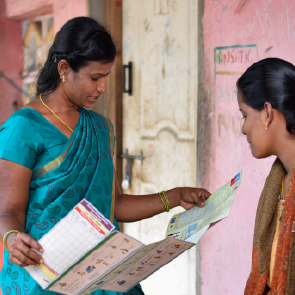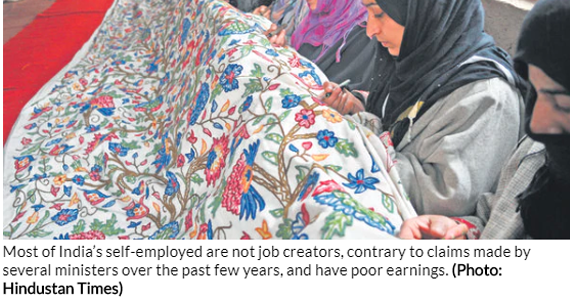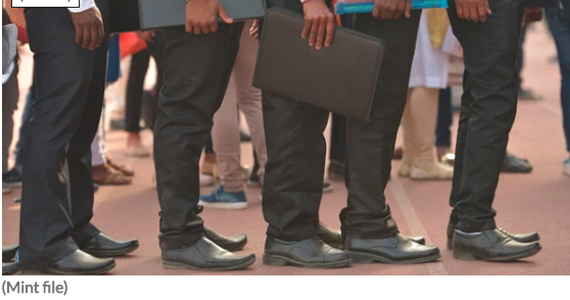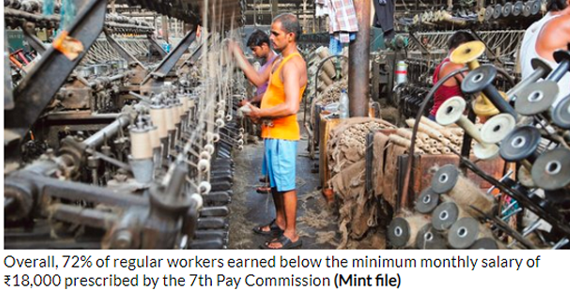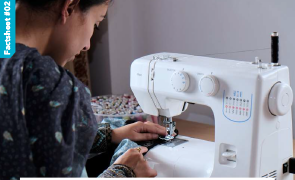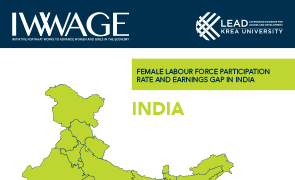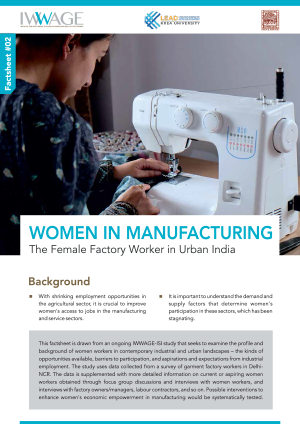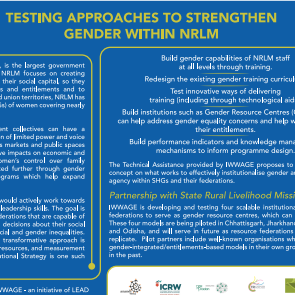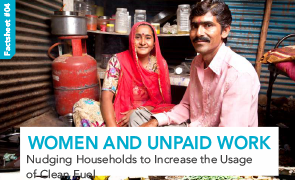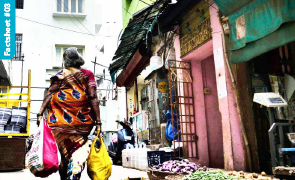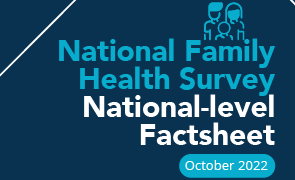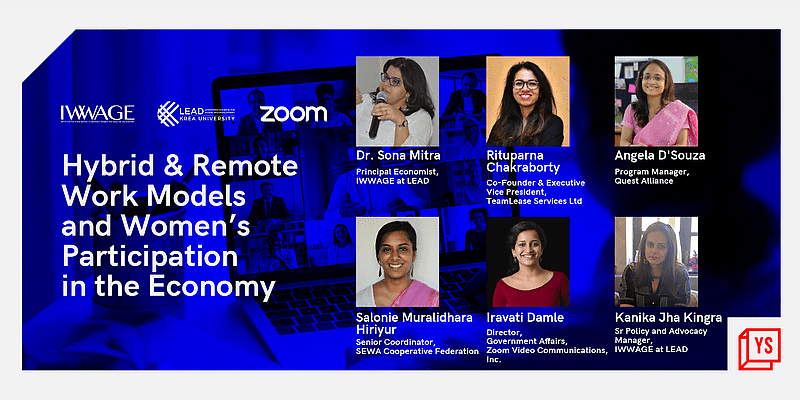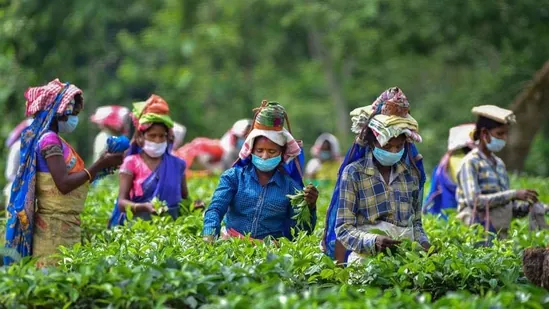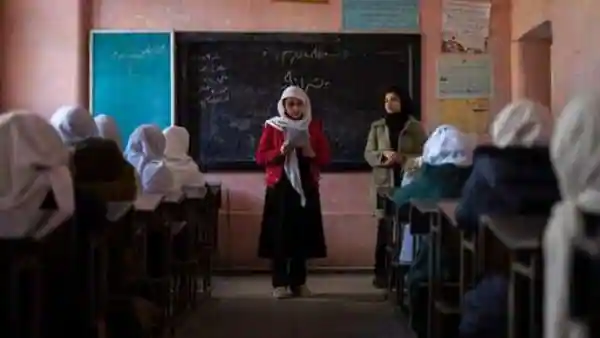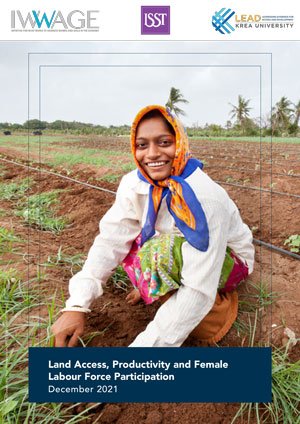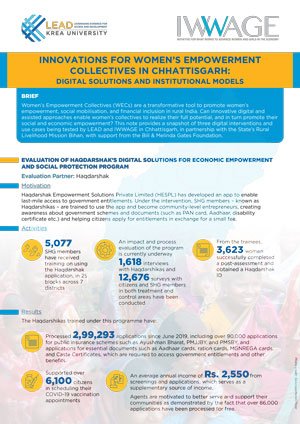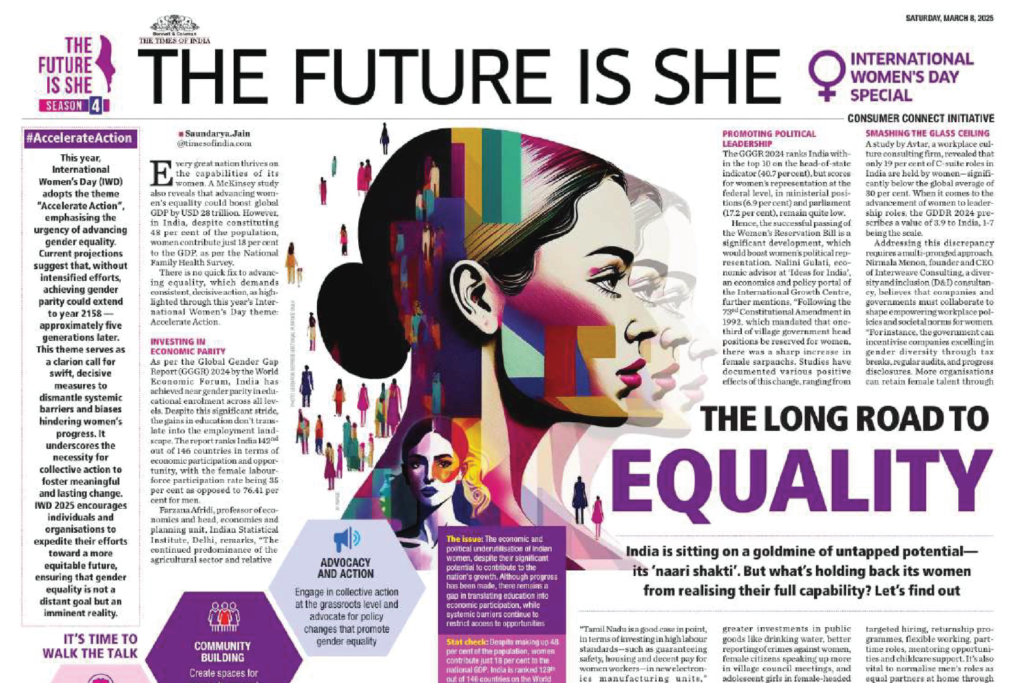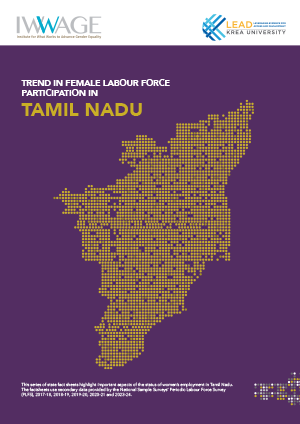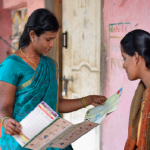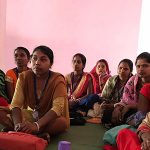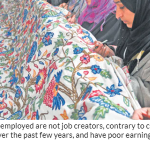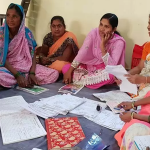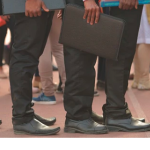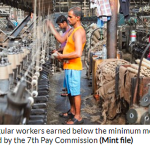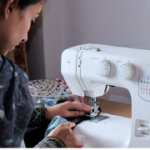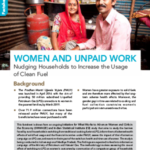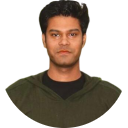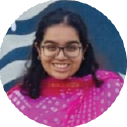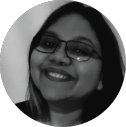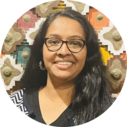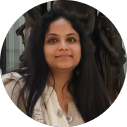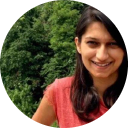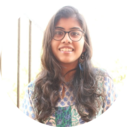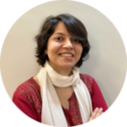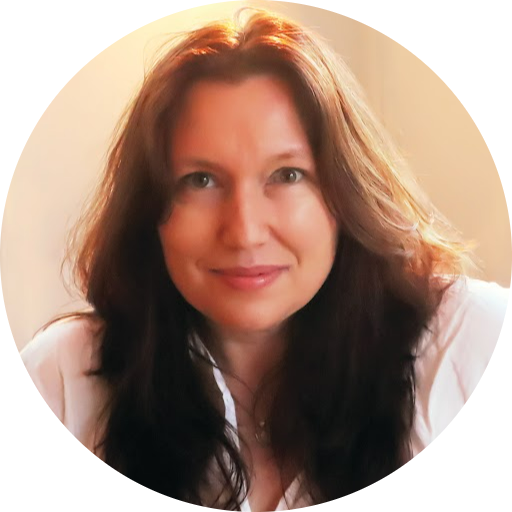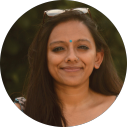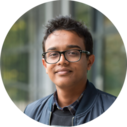test2
Generating Female Employment through Public Employment: A Scoping Paper
The employment generating potential of growth in India has been on the decline with unemployment and the lack of new...Read MoreEmpowering women through digital innovations
Women’s Self-Help Groups (SHGs) are an important and effective tool to promote women’s empowerment, social mobilisation, and financial inclusion in...Read MoreWomen’s work participation continues to decline: Evidence from the Periodic Labour Force Survey, 2017-18
The recently released Periodic Labour Force Survey (PLFS) – a new series of employment-unemployment estimates for 2017-18 produced by the...Read MoreWomen in Manufacturing
This factsheet is drawn from an ongoing IWWAGE-ISI study that seeks to examine the profile and background of women workers...Read MoreFemale Labour Force Participation Rate and Earnings Gap in India
Despite high economic growth, decline in fertility, and rise in schooling of girls, the Female Labour Force Participation Rate (FLFPR)...Read MoreWomen in Manufacturing
This factsheet is drawn from an IWWAGE-ISI study that seeks to examine the profile and background of women workers in...Read MoreTesting Approaches to Strengthen Gender within NRLM
With over 60 million women mobilised to be part of one of India’s largest livelihoods programme, the Deendayal Antayodaya Yojana-National...Read MoreEmpowering Women Collectives through Digital Initiatives in Chhattisgarh
Digital tools hold immense potential for accelerating women's empowerment and enhancing ongoing initiatives. Over the past year, IWWAGE, in collaboration...Read MoreDigital Solutions to Unlock the Potential of SHGs and their Federations
In collaboration with the State Rural Livelihoods Mission (SRLM) in Chhattisgarh and Haqdarshak Empowerment Solutions, IWWAGE is empowering women self-help...Read MoreAccelerating Women’s Access to Entitlements through Digital Solutions
In partnership with the State Rural Livelihoods Mission (SRLM) in Chhattisgarh and Haqdarshak Empowerment Solutions, IWWAGE is supporting SHG women-trained...Read MoreWomen and Unpaid Work
The methodology involves assessing the causal effect of switching to LPG on women’s outcomes by construction of a comparison group...Read MoreWomen and Unpaid Work
This study builds and tests a structural model that explains observed changes in FLFP using data on urban, married women...Read MoreWomen in Agriculture
This factsheet presents insights from an IWWAGE and Indian Statistical Institute (ISI) study exploring the impact of structural transformation in...Read MoreWomen and Unpaid Work
This factsheet highlights a study by IWWAGE and the Indian Statistical Institute (ISI) focused on the barriers rural households face...Read MoreWomen and Unpaid Work
This factsheet is based on a study by IWWAGE and the Indian Statistical Institute (ISI), which evaluates multiple constraints on...Read More
Empowering women through digital innovations
iwwage_admin / 27th February 2020Read More26 February 2020
Fabrizio Valenti
Women’s Self-Help Groups (SHGs) are an important and effective tool to promote women’s empowerment, social mobilisation, and financial inclusion in...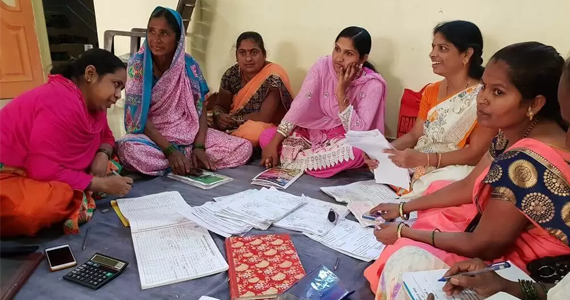
Women’s work participation continues to decline: Evidence from the Periodic Labour Force Survey, 2017-18
iwwage_admin / 20th February 2020Read More13 August 2019
Anjana Thampi and Ruchika Chaudhary
The recently released Periodic Labour Force Survey (PLFS) – a new series of employment-unemployment estimates for 2017-18 produced by the...National Family Health Survey
Despite high economic growth, decline in fertility, and rise in schooling of girls, the Female Labour Force Participation Rate (FLFPR)...Read MoreWomen and Work: How India Fared in 2021
The second wave of COVID-19 in 2021 exacerbated challenges for women and girls, deepening structural barriers. This report highlights efforts...Read MoreSocial Identities and Female Labour Force Participation in India
Caste remains a deeply entrenched form of social exclusion in South Asia, particularly in India, where it intersects with gender...Read MoreLand Access, Productivity and Female Labour Force Participation
Secure land rights are vital for women's economic empowerment and broader development outcomes. Evidence from countries like Pakistan, Nepal, Ethiopia,...Read MoreInnovations for Women’s Empowerment Collectives in Chhattisgarh
IWWAGE and LEAD at Krea University, in partnership with Bihan and with support from the Gates Foundation, piloted digital solutions...Read More- Second World Summit for Social Development | November 4-6, 2025 | Doha
- National Consultation on ‘Platform Work as an Enabler for Women’s Economic Empowerment’ | September 3, 2025 | New Delhi
- ANJALI S
- Promoting Women’s Engagement in the Gig Economy, IWWAGE at Access Livelihoods Summit 2024
- Gender Gap in Private School Enrolment Reiterates Gendered Investment by Households on Education
- Panel Discussion: Propelling India’s Care Economy – Achievements, Challenges, and Strategies for the Future
- The Future is SHE
- Trends in Female Labour and Workforce Participation – Tamil Nadu
- Trends in Female Labour and Workforce Participation – Karnataka
- IWWAGE Bi-Monthly Seminar: Gender Transformative Evaluation- Why and How?
- Rachita Malik
- Sharati Madhur Roy
- Aditi Vyas
- IWWAGE at Global Evaluation Initiatives gLOCAL Evaluation Week 2024
- Roundtable Consultation on Emerging Elderly Care Models
- IWWAGE at the second edition of the Asia Pacific Care Forum in Bangkok
- IWWAGE at the 2nd Gender Dialogues
- IWWAGE at National Seminar on Women and Employment in India
- Workshop on Financing Quality Childcare Facilities in India
- Building Resilient Communities: Women and Sustainable Ecosystems
{"ticker_effect":"slide-v","autoplay":"true","speed":3000,"font_style":"normal"}Generating Female Employment through Public Employment: A Scoping Paper
The employment generating potential of growth in India has been on the decline with unemployment and the lack of new...Read MoreEmpowering women through digital innovations
Women’s Self-Help Groups (SHGs) are an important and effective tool to promote women’s empowerment, social mobilisation, and financial inclusion in...Read MoreWomen’s work participation continues to decline: Evidence from the Periodic Labour Force Survey, 2017-18
The recently released Periodic Labour Force Survey (PLFS) – a new series of employment-unemployment estimates for 2017-18 produced by the...Read MoreWomen in Manufacturing
This factsheet is drawn from an ongoing IWWAGE-ISI study that seeks to examine the profile and background of women workers...Read MoreFemale Labour Force Participation Rate and Earnings Gap in India
Despite high economic growth, decline in fertility, and rise in schooling of girls, the Female Labour Force Participation Rate (FLFPR)...Read MoreWomen in Manufacturing
This factsheet is drawn from an IWWAGE-ISI study that seeks to examine the profile and background of women workers in...Read MoreTesting Approaches to Strengthen Gender within NRLM
With over 60 million women mobilised to be part of one of India’s largest livelihoods programme, the Deendayal Antayodaya Yojana-National...Read MoreEmpowering Women Collectives through Digital Initiatives in Chhattisgarh
Digital tools hold immense potential for accelerating women's empowerment and enhancing ongoing initiatives. Over the past year, IWWAGE, in collaboration...Read MoreDigital Solutions to Unlock the Potential of SHGs and their Federations
In collaboration with the State Rural Livelihoods Mission (SRLM) in Chhattisgarh and Haqdarshak Empowerment Solutions, IWWAGE is empowering women self-help...Read MoreAccelerating Women’s Access to Entitlements through Digital Solutions
In partnership with the State Rural Livelihoods Mission (SRLM) in Chhattisgarh and Haqdarshak Empowerment Solutions, IWWAGE is supporting SHG women-trained...Read MoreWomen and Unpaid Work
The methodology involves assessing the causal effect of switching to LPG on women’s outcomes by construction of a comparison group...Read MoreWomen and Unpaid Work
This study builds and tests a structural model that explains observed changes in FLFP using data on urban, married women...Read MoreWomen in Agriculture
This factsheet presents insights from an IWWAGE and Indian Statistical Institute (ISI) study exploring the impact of structural transformation in...Read MoreWomen and Unpaid Work
This factsheet highlights a study by IWWAGE and the Indian Statistical Institute (ISI) focused on the barriers rural households face...Read MoreWomen and Unpaid Work
This factsheet is based on a study by IWWAGE and the Indian Statistical Institute (ISI), which evaluates multiple constraints on...Read More
Empowering women through digital innovations
iwwage_admin / 27th February 2020Read More26 February 2020
Fabrizio Valenti
Women’s Self-Help Groups (SHGs) are an important and effective tool to promote women’s empowerment, social mobilisation, and financial inclusion in...
Women’s work participation continues to decline: Evidence from the Periodic Labour Force Survey, 2017-18
iwwage_admin / 20th February 2020Read More13 August 2019
Anjana Thampi and Ruchika Chaudhary
The recently released Periodic Labour Force Survey (PLFS) – a new series of employment-unemployment estimates for 2017-18 produced by the...National Family Health Survey
Despite high economic growth, decline in fertility, and rise in schooling of girls, the Female Labour Force Participation Rate (FLFPR)...Read MoreWomen and Work: How India Fared in 2021
The second wave of COVID-19 in 2021 exacerbated challenges for women and girls, deepening structural barriers. This report highlights efforts...Read MoreSocial Identities and Female Labour Force Participation in India
Caste remains a deeply entrenched form of social exclusion in South Asia, particularly in India, where it intersects with gender...Read MoreLand Access, Productivity and Female Labour Force Participation
Secure land rights are vital for women's economic empowerment and broader development outcomes. Evidence from countries like Pakistan, Nepal, Ethiopia,...Read MoreInnovations for Women’s Empowerment Collectives in Chhattisgarh
IWWAGE and LEAD at Krea University, in partnership with Bihan and with support from the Gates Foundation, piloted digital solutions...Read More- Second World Summit for Social Development | November 4-6, 2025 | Doha
- National Consultation on ‘Platform Work as an Enabler for Women’s Economic Empowerment’ | September 3, 2025 | New Delhi
- ANJALI S
- Promoting Women’s Engagement in the Gig Economy, IWWAGE at Access Livelihoods Summit 2024
- Gender Gap in Private School Enrolment Reiterates Gendered Investment by Households on Education
- Panel Discussion: Propelling India’s Care Economy – Achievements, Challenges, and Strategies for the Future
- The Future is SHE
- Trends in Female Labour and Workforce Participation – Tamil Nadu
- Trends in Female Labour and Workforce Participation – Karnataka
- IWWAGE Bi-Monthly Seminar: Gender Transformative Evaluation- Why and How?
- Rachita Malik
- Sharati Madhur Roy
- Aditi Vyas
- IWWAGE at Global Evaluation Initiatives gLOCAL Evaluation Week 2024
- Roundtable Consultation on Emerging Elderly Care Models
- IWWAGE at the second edition of the Asia Pacific Care Forum in Bangkok
- IWWAGE at the 2nd Gender Dialogues
- IWWAGE at National Seminar on Women and Employment in India
- Workshop on Financing Quality Childcare Facilities in India
- Building Resilient Communities: Women and Sustainable Ecosystems
{"ticker_effect":"slide-v","autoplay":"true","speed":3000,"font_style":"normal"}


